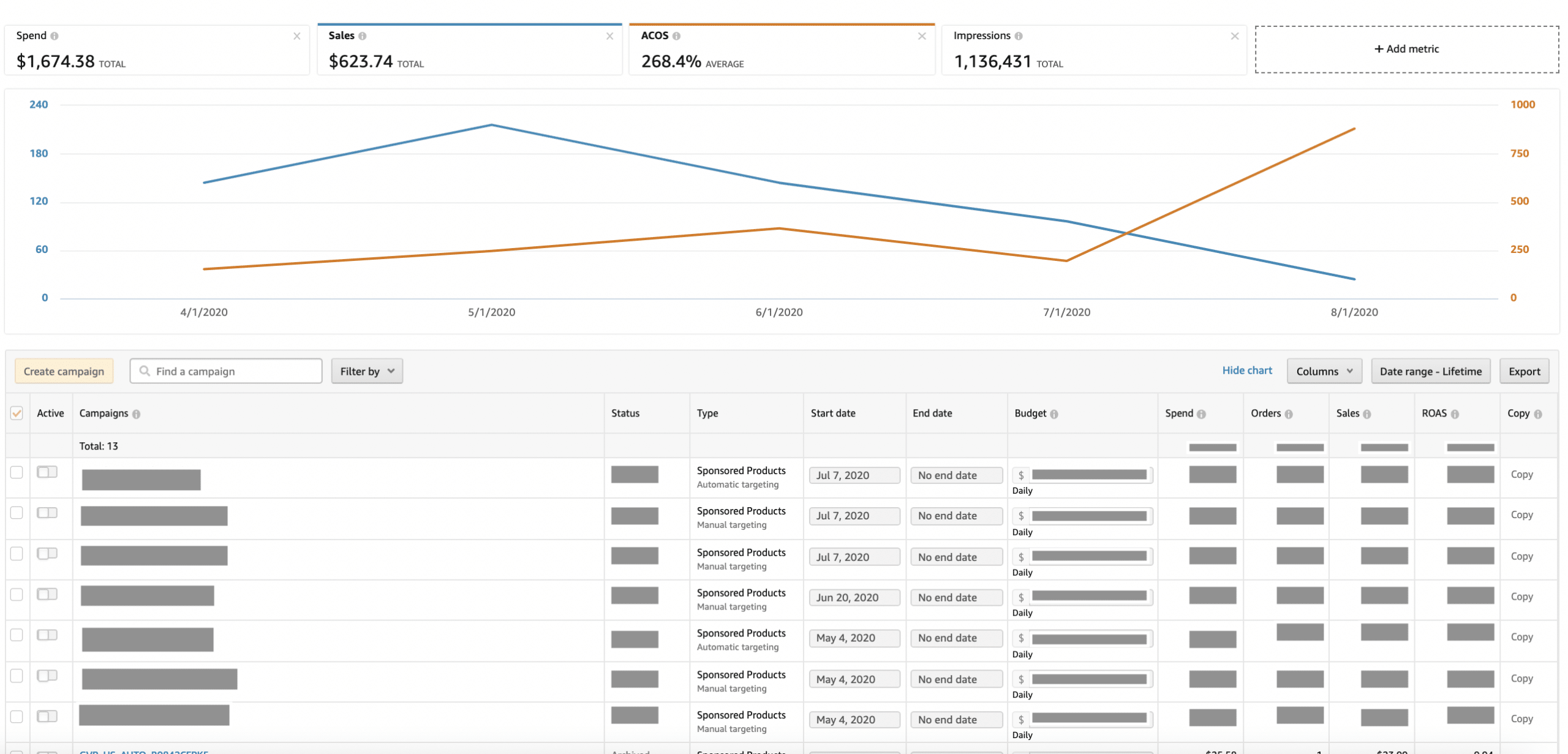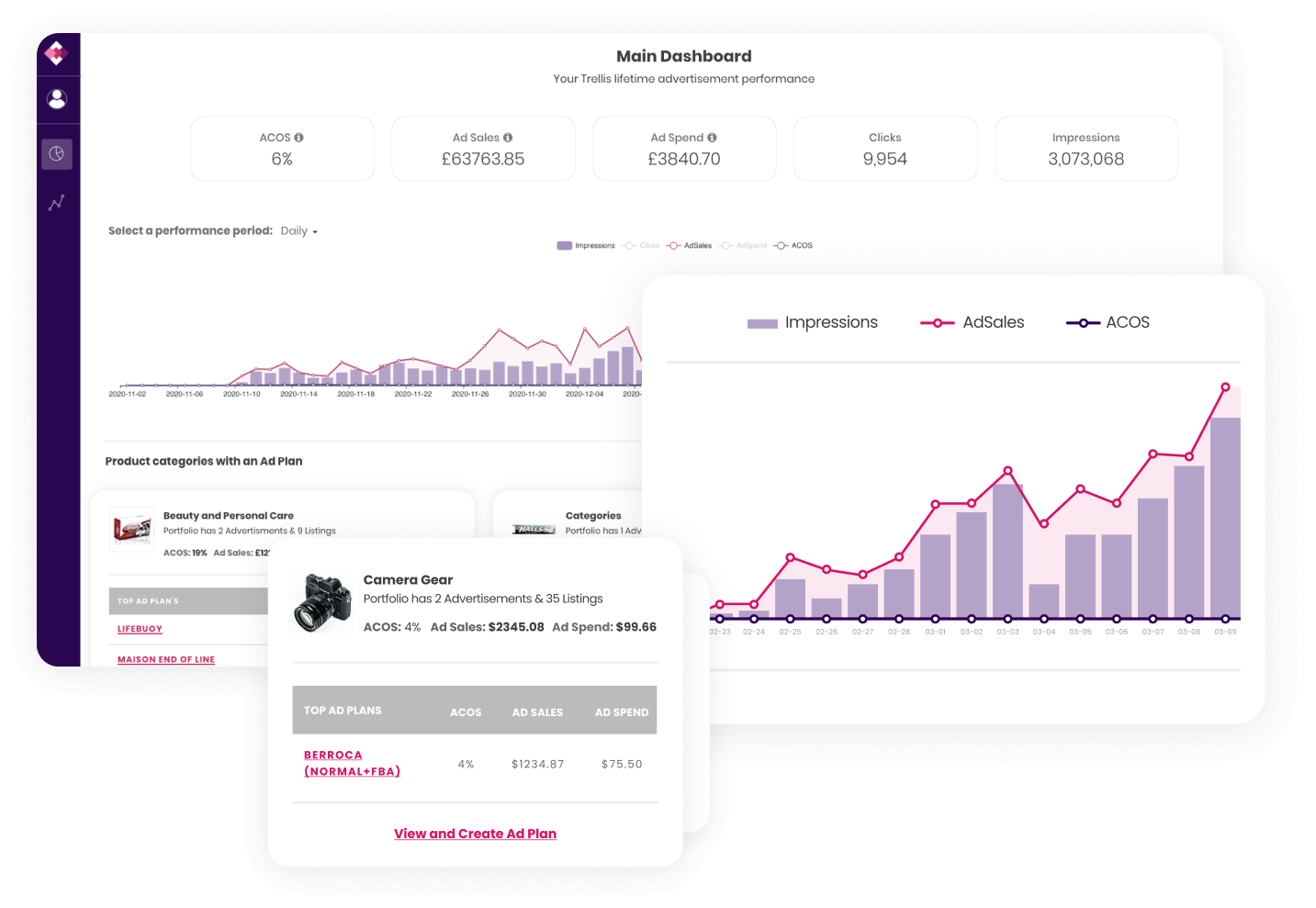Selling on Amazon has a lot of advantages when you tap into the resources available to maximize reach and sales.
With 3+ million active sellers and declining ROAS on this behemoth search engine for eCommerce, why should brands leverage Amazon Auto Campaigns?
Amazon Automatic Campaigns allow you to discover new keywords that would increase your profits and reduce ad spending.
Hence, saving money, time, and creating efficient campaigns across multiple products.
In this blog, we will explore:
- Why use Amazon Auto Campaigns for your Amazon keyword strategy, and
- How to leverage the Amazon auto-campaign feature for manual campaigns.
Keyword Discovery: Optimize New Amazon Keywords
When brands advertise products on Amazon, the competition is fierce and Amazon will naturally prioritize the visibility of ads that are making them the most money.
It’s more important than ever for you to have a solid system in place for discovering and optimizing keywords that reach new buyers who will purchase your products.
Leveraging auto-targeting in your Amazon PPC campaigns allows you to benefit from the data that Amazon has but does not share.
👉 Need help calculating your ACoS? Use our free ACoS calculator here.
Tap into Amazon’s Big Data
You can tap into Amazon’s data to identify keywords that are driving the most sales. It gives advertisers a competitive edge on their keyword strategy improving their ad campaigns.
Automatic Campaigns give brands visibility into keywords that might not have been considered when setting up the ads. And it’s not just keywords, but competitive products too.
Better Product Targeting
Amazon Auto Campaigns also let you find competitive products or ASINs. Those products are your direct competitors and auto campaigns help you identify them to optimize your campaigns better.
Product targeting with keyword targeting can give you even better results. Amazon looks at purchase behaviour of both targeting methods: finding the best search keywords and the most similar competitor products.
Auto Campaigns also lets you find the best keywords that could have been missed.

Remove Human Bias in Keyword Strategy
As humans, we are limited in what we consider to be relevant keywords for our products. We have certain biases toward language and the use of words based on our cultures, geography, and lifestyles.
For example, in the United States, we refer to the clothing on men’s legs as pants and in the United Kingdom, they are called trousers, and universally they are referred to as slacks. Another example is searching ‘wine shelf’ or ‘wine shelving’. Some may search ‘wine storage’ for the same solution.
We usually have tunnel vision when considering the end solution to our products. We tend to miss out on keywords that might lead to a sale at a cheaper rate. While unexpected keywords may lack volume and high conversion rates, it comes with the benefit of low competition and low CPCs.
Building a workflow identifying these keywords could open up an additional revenue source that comes at an increase to your ROAS.
Save Time, Energy, Effort, and Ad Spend
Since people search for products in different ways, brands competing for sales can learn which keywords are driving the highest sales for each product with Auto Campaigns.
This is a process that if done manually would require a lot of time, effort, and refinement. Especially if you have a lot of products.
To manually find the best bidding and pricing, or even the type of ad, you need time. Depending on your other daily tasks, it may not seem worth it to optimize your keywords in this way. Though, this attitude could cascade into a huge loss of opportunity for your business.
Most Amazon sellers understand that and add automation to areas where they sometimes need less control and more insight, such as keyword strategy.
Keyword Harvesting: Optimize for Manual Campaigns
Keyword harvesting is also continually adding negative keywords to the Auto Campaign once keywords are determined top-performing after moving them to the Manual Campaigns so advertisers aren’t double-spending on those keywords.
Advertisers will have finer control over the bids of those keywords in the Manual Campaign while saving money, and optimizing for ROAS. Because every keyword is bid on equally in Auto Campaigns, the best converting words will not maximize profits in Auto Campaigns.
Once you gain the research from the keywords in your Auto Campaigns, moving them into your Manual Campaigns will allow you to optimize your bids more effectively on search terms that are driving high returns and lower returns. If keywords are converting at 5% or more, you can increase your bids to reach a wider audience with better positioning to maximize more sales. And you can also bid less for words that are converting but not at as high of a return.
This is a continual process that requires refinement. Auto Campaigns helps advertisers understand which keywords are the most profitable. Having automation tools available to your program will help save time and money.
Keyword Harvesting: Optimize for Manual Campaigns
Keyword harvesting is a process to find the most relevant keywords for your products to either add (positive harvesting) or remove (negative harvesting) them from your campaigns. Those keywords are usually found in Amazon Search Term Reports.
After running Amazon’s Auto Campaigns to learn which keywords are driving profitability, advertisers transfer those search terms into the Manual Campaigns to optimize the ad spend and visibility.
Amazon has vast amounts of data about which keywords might help drive sales for your product. It is important that we tap into this data set as this is not available anywhere else.
Doing it this way will save time, cast a wide net, and automate the complexities of discovering and refining these words.
Harvest Keywords for Profitability
Once you learn the keywords that are converting at the highest level, those high-converting keywords can be moved into an exact-match Manual Campaign. Manual Campaign is where advertisers have more control over the bidding optimization of keywords that are driving ROAS.
Using the Search Term Reports from Auto Campaigns, you can build a wide purview to determine which keywords are driving and hurting profitability.
Identify Negative Keywords
To further increase profitability, keyword harvesting lets you identify the keywords hurting your Amazon PPC campaign that is continually added to the negative keywords list.
Once you gain the research from the negative or poor-performing keywords in your Auto Campaigns, moving them into your Manual Campaigns will allow you to optimize your bids more effectively on search terms that are driving higher and lower returns.
If keywords are converting above your benchmarks, you can increase your bids to reach a wider audience with better positioning to maximize sales. And you can also bid less for words that are converting but not at as high of a return.
Auto Vs Manual
When marketing in 2022, the question is no longer auto vs. manual but how can you use automation to support more human-driven efforts.
In manual campaigns, you have finer control over the bids of your keywords in Manual Campaign allowing you to save money, and optimize for ROAS. This is important, because every keyword is bid equally in Auto Campaigns, and you can’t focus your budget on the best-converting terms.
However, Auto Campaigns can help us find and refine which keywords are the most profitable. Having automation tools available will help save time and money.
Once you have better-performing keywords identified, you can make regular adjustments on campaigns such as moving top-performing keywords to Manual Campaigns and shifting low-performing words to negative keyword lists to avoid wasteful spending. This saves you time and money, all while maximizing reach across the product line.
The goal of using Auto Campaigns is to use it as a research tool for the overall marketing mix. Setting up an Auto Campaign is as easy as flipping a switch in the Amazon advertising campaign’s dashboard.
However, this process gets too complicated and messy when you have several campaigns and dozens of products.
Our Solution: Synergizing Manual and Automated Keyword Harvesting
Trellis combines Amazon’s automation functionality while actively making “manual” inputs on keywords and bids. By expanding on Amazon’s current automation functionality, Trellis is able to automate the full workflow by automating the manual controls. This means a semantic and statistical awareness about the keywords you’re bidding on to properly adapt, no matter the size of your company or product line.
By automating Keyword Harvesting and your bidding strategy we can grow your business beyond human bias and your time constraints. You can leave your ads alone with peace of mind, knowing that your campaigns are being optimized daily.

“Trellis has removed the complexity by automating the process. In less than 4 weeks, Trellis was able to increase ad sales by 88% and reduce ACoS by 14%.” – PetPeppy

If you want to see how our platform works, sign-up for a demo today.



